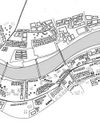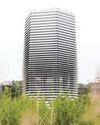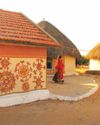By transforming a 60’s era pharmaceutical warehouse in the Okhla Industrial Area of New Delhi into a swanky, industrial chic office space for a creative agency, Studio Bipolar have not only created a shining example of how a design intervention can highlight the dormant beauty of our older buildings, but also made a compelling, aesthetic case for adaptive reuse of structures we would otherwise be tempted to demolish and rebuild upon.

Often when older structures are past their moment in time, the dilemma is whether to refurbish and use, or demolish and start over. While the do-over approach might sound appealing on the surface, it discounts the cultural context or heritage value. However, the argument against refurbishing stands to reason that often times an arbitrary, and unnecessary, value is ascribed to older structures simply on the basis of their age. How do we then strike a balance? How do we, as objectively as possible, zero in on the best, most logical course of action?
Also, does all this hold true for buildings that probably do not have cultural or conservational value? For instance, a 60’s era pharmaceutical warehouse in the Okhla Industrial Area of New Delhi? How would we arrive at the value of nostalgia here, if at all? When Studio Bipolar set out to create a 6000 square feet office and film studio for WhiteBalance, a creative agency, they perhaps pondered over such questions. Their approach, however, was to highlight the hidden beauty of the structure and transform it into a space that resonates the bustling energy of the creative agency and its employees who would inhabit the space.
هذه القصة مأخوذة من طبعة July 2019 من Indian Architect & Builder.
ابدأ النسخة التجريبية المجانية من Magzter GOLD لمدة 7 أيام للوصول إلى آلاف القصص المتميزة المنسقة وأكثر من 9,000 مجلة وصحيفة.
بالفعل مشترك ? تسجيل الدخول
هذه القصة مأخوذة من طبعة July 2019 من Indian Architect & Builder.
ابدأ النسخة التجريبية المجانية من Magzter GOLD لمدة 7 أيام للوصول إلى آلاف القصص المتميزة المنسقة وأكثر من 9,000 مجلة وصحيفة.
بالفعل مشترك? تسجيل الدخول

Interlacing Perspectives
‘Meraki-2019’ A visionary Seminar series presented by Dr.Baliram Hiray College of Architecture, Bandra(East), Mumbai.

Facilitating A Community Through Architectural Practice
The humble, self-designed, self-built and organically planned home built by the majority of the world population rarely gets appreciated and critiqued as a viable lesson in architectural design.

The Art Of Solving Problems Creatively
The practice of architecture is perhaps incomplete without the complement of a variety of other arts.

Upcycling towards a playful tomorrow
Play is like the middle child, often forgotten, and always taking a back seat. For young kids, play can simply be running around, armwrestling with friends, building sandcastles on the beach, or singing popular music tracks in the shower.

Balancing The Poetics And Pragmatism Of Everyday Design
Humanity is faced with an oxymoronic crisis. The crisis involves the earth, the environment, impending looms of climate change, deforestation, loss of species, dwindling resources etc.

Just Give Me Some Space: Discussions And Beyond
Just Give Me Some Space (JGMSS) is Suha Riyaz Khopatkar’s debut book that paints a portrait of the dynamic life of an architecture student.

The Next In Vernacular Architecture
Architecture has become a capitalist.

Rethinking The Future: Architecture And Its Education
“I want to be like animals, the bird makes a nest in one or two days, the rat digs a hole in a night, but intelligent humans like us spend 30 years to have a house, that’s wrong.” - Jon Jandai

Uniting The Human-Scale With The City-Scale
London-based architect Usman Haque is famed for his interactive architectural systems, and for his exploration of newer, more effective ways of creating human engagement and interaction through his designs. Indian Architect & Builder caught up with him, to quiz him on a variety of topics such as his journey as an architect, his inspirations and philosophies, architects using the digital revolution to their advantage, and more!

Framing spaces
Almost every architect also doubles as a photographer or at least an enthusiast.